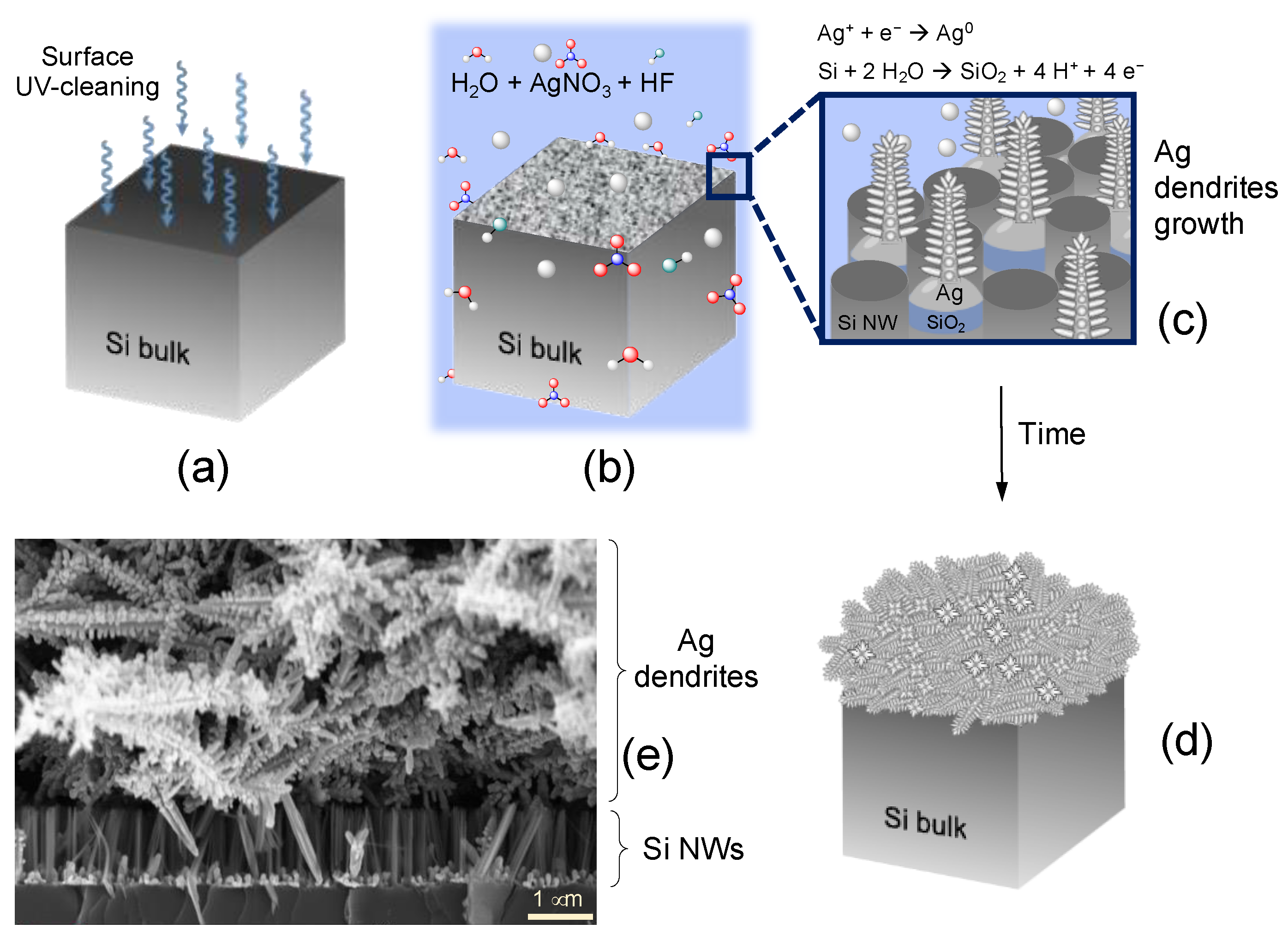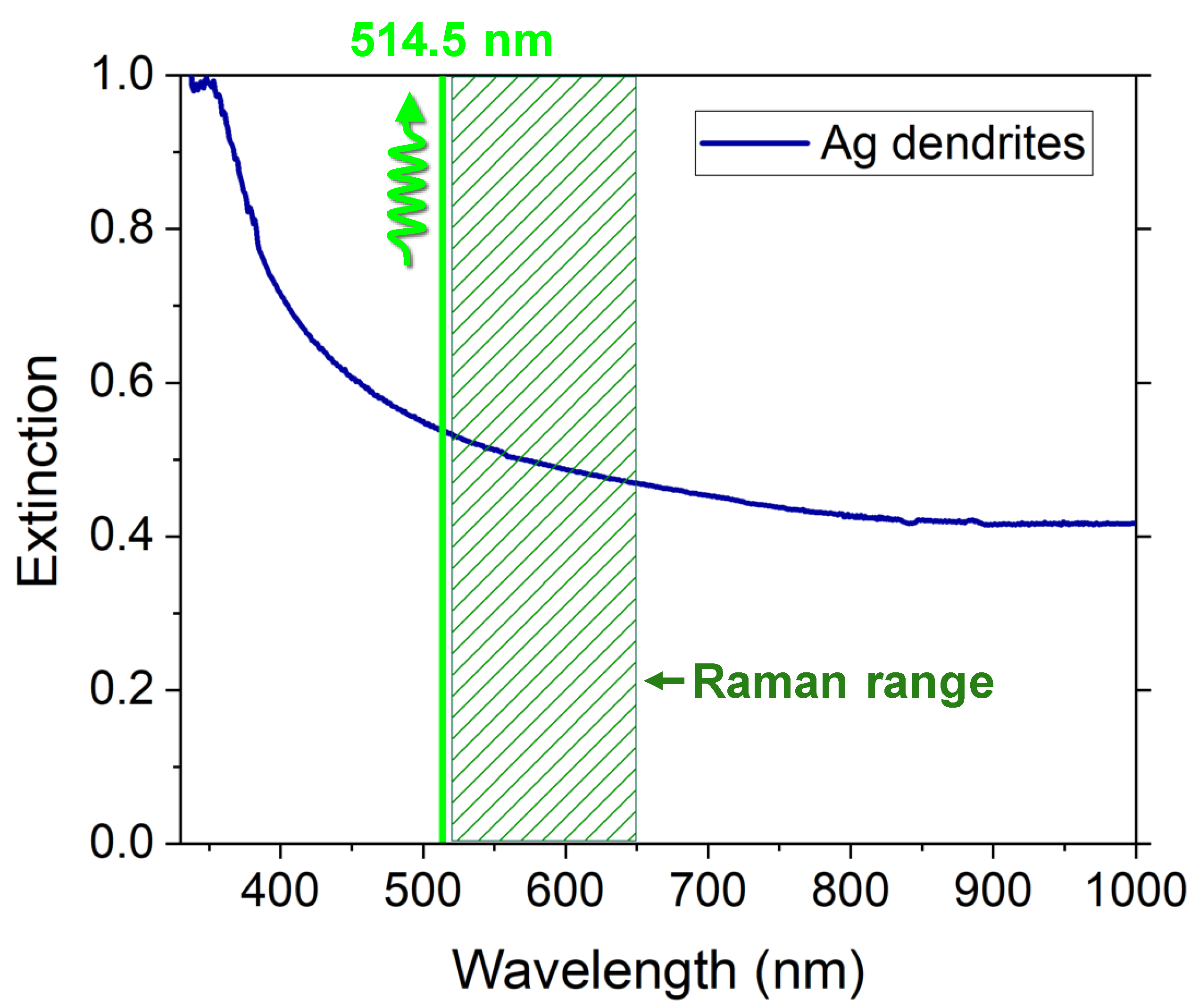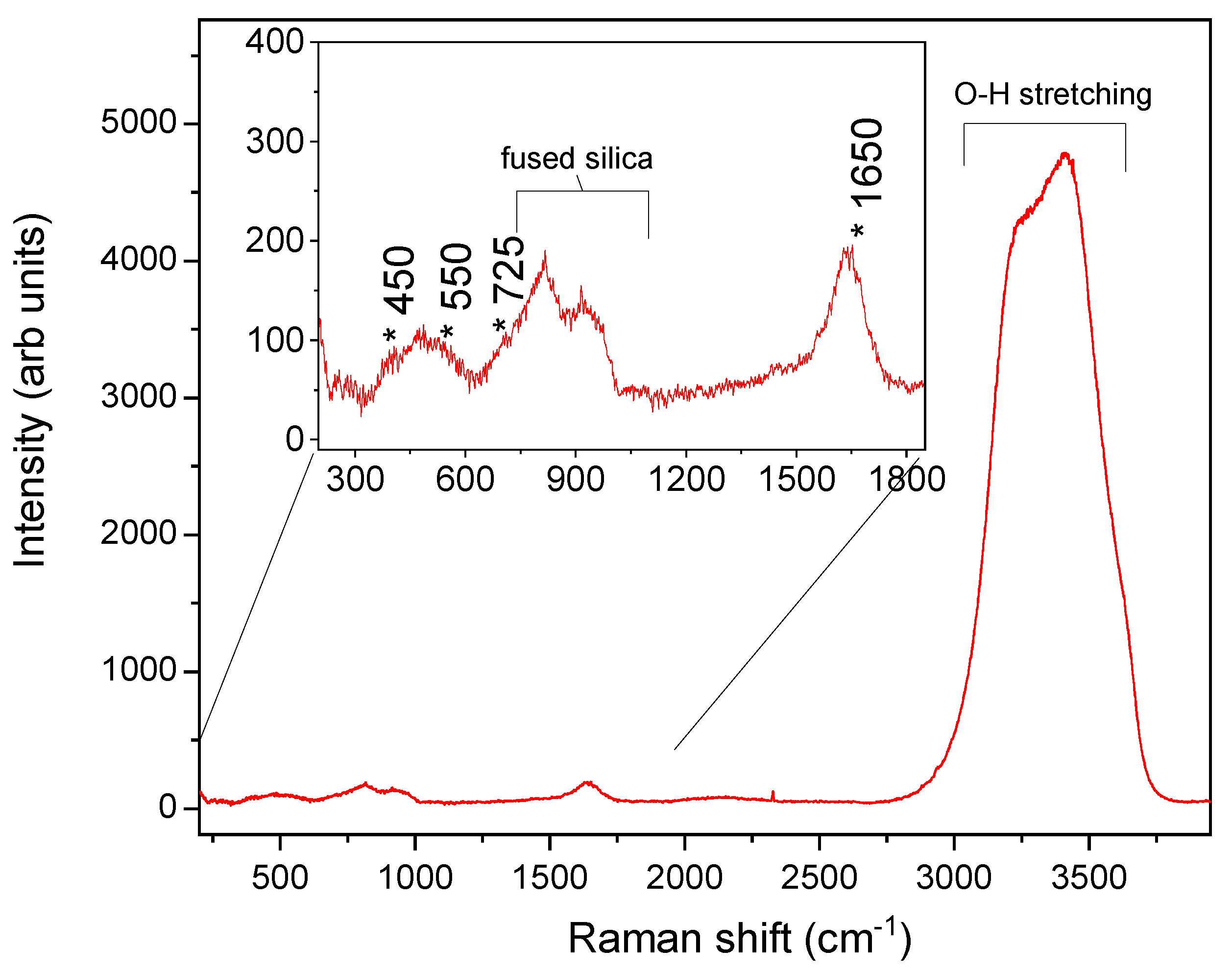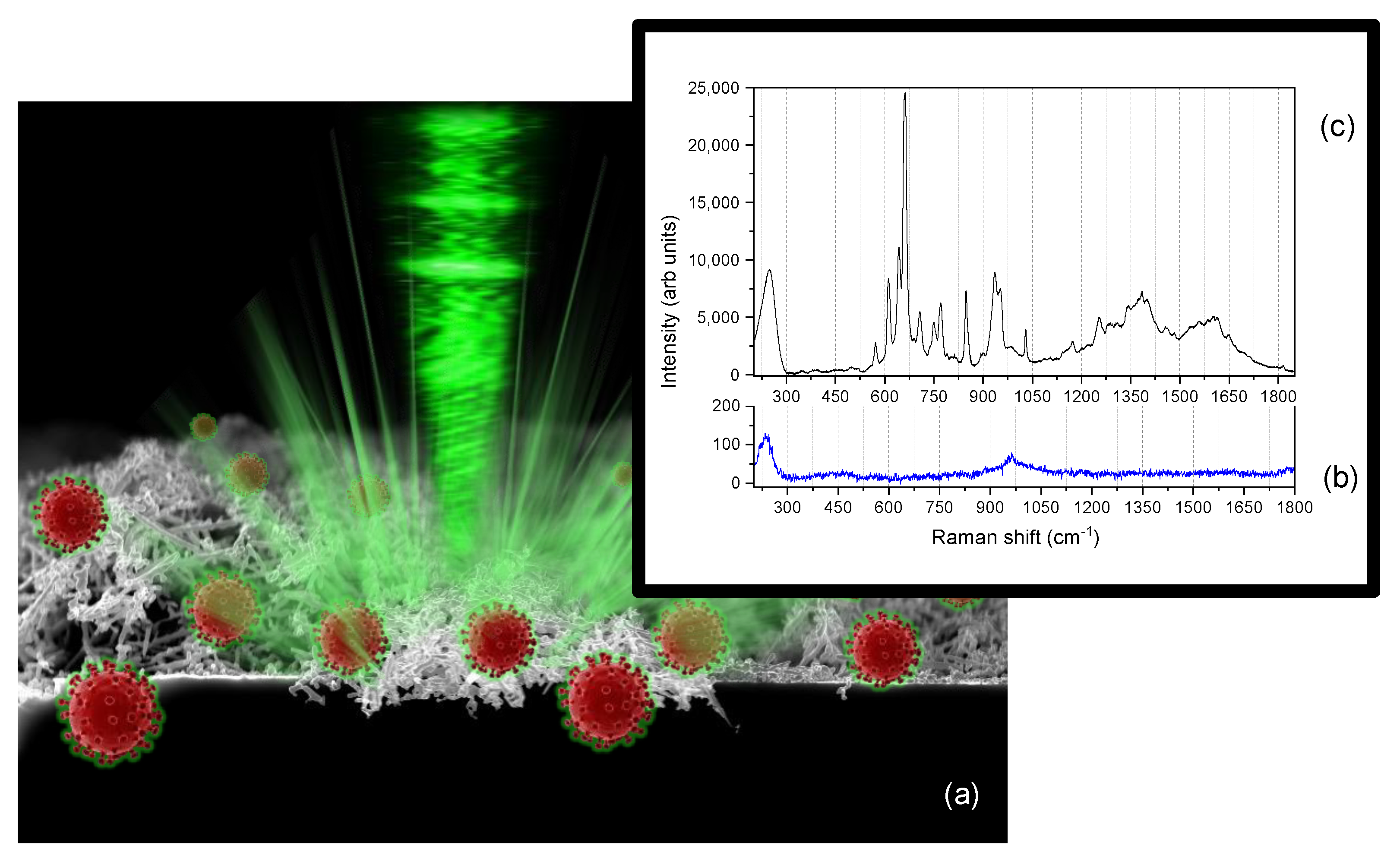Molecular Fingerprinting of the Omicron Variant Genome of SARS-CoV-2 by SERS Spectroscopy
Abstract
1. Introduction
2. Materials and Methods
2.1. SARS-CoV-2 Genome Preparation
2.2. Ag Dendrites: Chemicals, and Structural and Optical Measurements
2.3. Raman and SERS Measurements
3. Results and Discussion
3.1. Synthesis and Characterization of Ag Dendrites
3.2. Identification of Raman Vibrational Fingerprints of Genome of SARS-CoV-2 Omicron Variant
4. Conclusions and Perspectives
Supplementary Materials
Author Contributions
Funding
Institutional Review Board Statement
Informed Consent Statement
Data Availability Statement
Acknowledgments
Conflicts of Interest
References
- Hoffmann, M.; Krüger, N.; Schulz, S.; Cossmann, A.; Rocha, C.; Kempf, A.; Nehlmeier, I.; Graichen, L.; Moldenhauer, A.S.; Winkler, M.S.; et al. The Omicron Variant Is Highly Resistant against Antibody-Mediated Neutralization: Implications for Control of the COVID-19 Pandemic. Cell 2022, 185, 447–456.e11. [Google Scholar] [CrossRef] [PubMed]
- Munne, K.; Bhanothu, V.; Bhor, V.; Patel, V.; Mahale, S.D.; Pande, S. Detection of SARS-CoV-2 Infection by RT-PCR Test: Factors Influencing Interpretation of Results. Virus Dis. 2021, 32, 187–189. [Google Scholar] [CrossRef] [PubMed]
- Jin, Y.H.; Cai, L.; Cheng, Z.S.; Cheng, H.; Deng, T.; Fan, Y.P.; Fang, C.; Huang, D.; Huang, L.Q.; Huang, Q.; et al. A Rapid Advice Guideline for the Diagnosis and Treatment of 2019 Novel Coronavirus (2019-NCoV) Infected Pneumonia (Standard Version). Mil. Med. Res. 2020, 7, 1–23. [Google Scholar] [CrossRef] [PubMed]
- Cheng, C.M. Small-Volume Point-of-Care Analytical Methods. Sci. Rep. 2020, 10, 14230. [Google Scholar] [CrossRef]
- Koczula, K.M.; Gallotta, A. Lateral Flow Assays. Essays Biochem. 2016, 60, 111–120. [Google Scholar] [CrossRef]
- The Cost of Sequencing a Human Genome. Available online: https://www.genome.gov/about-genomics/fact-sheets/Sequencing-Human-Genome-cost (accessed on 5 May 2022).
- Shendure, J.; Ji, H. Next-Generation DNA Sequencing. Nat. Biotechnol. 2008, 26, 1135–1145. [Google Scholar] [CrossRef]
- Shendure, J.; Balasubramanian, S.; Church, G.M.; Gilbert, W.; Rogers, J.; Schloss, J.A.; Waterston, R.H. DNA Sequencing at 40: Past, Present and Future. Nature 2017, 550, 345–353. [Google Scholar] [CrossRef]
- Souf, S. Recent Advances in Diagnostic Testing for Viral Infections. Biosci. Horiz. Int. J. Stud. Res. 2016, 9, hzw010. [Google Scholar] [CrossRef]
- de La Rica, R.; Stevens, M.M. Plasmonic ELISA for the Detection of Analytes at Ultralow Concentrations with the Naked Eye. Nat. Protoc. 2013, 8, 1759–1764. [Google Scholar] [CrossRef]
- Anker, J.N.; Hall, W.P.; Lyandres, O.; Shah, N.C.; Zhao, J.; van Duyne, R.P. Biosensing with Plasmonic Nanosensors. Nat. Mater. 2008, 7, 442–453. [Google Scholar] [CrossRef]
- Leonardi, A.A.; lo Faro, M.J.; Irrera, A. Biosensing Platforms Based on Silicon Nanostructures: A Critical Review. Anal. Chim. Acta 2021, 1160, 338393. [Google Scholar] [CrossRef]
- Sciuto, E.L.; Bongiorno, C.; Scandurra, A.; Petralia, S.; Cosentino, T.; Conoci, S.; Sinatra, F.; Libertino, S. Functionalization of Bulk SiO2 Surface with Biomolecules for Sensing Applications: Structural and Functional Characterizations. Chemosensors 2018, 6, 59. [Google Scholar] [CrossRef]
- Brandolini, M.; Taddei, F.; Marino, M.M.; Grumiro, L.; Scalcione, A.; Turba, M.E.; Gentilini, F.; Fantini, M.; Zannoli, S.; Dirani, G.; et al. Correlating QRT-PCR, DPCR and Viral Titration for the Identification and Quantification of SARS-CoV-2: A New Approach for Infection Management. Viruses 2021, 13, 1022. [Google Scholar] [CrossRef]
- Weber, W.H.; Merlin, R. Raman Scattering in Materials Science; Springer Series in Materials Science; Springer: Berlin/Heidelberg, Germany, 2000; Volume 42, ISBN 978-3-642-08656-4. [Google Scholar]
- Cantarero, A. Raman Scattering Applied to Materials Science. Procedia Mater. Sci. 2015, 9, 113–122. [Google Scholar] [CrossRef]
- Fazio, B.; Vulpio, M.; Gerardi, C.; Liao, Y.; Crupi, I.; Lombardo, S.; Trusso, S.; Neri, F. Residual Crystalline Silicon Phase in Silicon-Rich-Oxide Films Subjected to High Temperature Annealing. J. Electrochem. Soc. 2002, 149, G376. [Google Scholar] [CrossRef]
- lo Faro, M.J.; Ruello, G.; Leonardi, A.A.; Morganti, D.; Irrera, A.; Priolo, F.; Gigan, S.; Volpe, G.; Fazio, B. Visualization of Directional Beaming of Weakly Localized Raman from a Random Network of Silicon Nanowires. Adv. Sci. 2021, 8, 2100139. [Google Scholar] [CrossRef]
- Gares, K.L.; Hufziger, K.T.; Bykov, S.V.; Asher, S.A. Review of Explosive Detection Methodologies and the Emergence of Standoff Deep UV Resonance Raman. J. Raman Spectrosc. 2016, 47, 124–141. [Google Scholar] [CrossRef]
- Cantu, L.M.L.; Gallo, E.C.A. Explosives and Warfare Agents Remote Raman Detection on Realistic Background Samples. Eur. Phys. J. Plus 2022, 137, 207. [Google Scholar] [CrossRef]
- Chen, M.C.; Lord, R.C. Laser-Excited Raman Spectroscopy of Biomolecules. VIII. Conformational Study of Bovine Serum Albumin. J. Am. Chem. Soc. 1976, 98, 990–992. [Google Scholar] [CrossRef]
- Puppels, G.J.; de Mul, F.F.M.; Otto, C.; Greve, J.; Robert-Nicoud, M.; Arndt-Jovin, D.J.; Jovin, T.M. Studying Single Living Cells and Chromosomes by Confocal Raman Microspectroscopy. Nature 1990, 347, 301–303. [Google Scholar] [CrossRef]
- David, C.; D’Andrea, C.; Lancelot, E.; Bochterle, J.; Guillot, N.; Fazio, B.; Marag, O.M.; Sutton, A.; Charnaux, N.; Neubrech, F.; et al. Raman and IR Spectroscopy of Manganese Superoxide Dismutase, a Pathology Biomarker. Vib. Spectrosc. 2012, 62, 50–58. [Google Scholar] [CrossRef]
- Venuti, V.; Crupi, V.; Fazio, B.; Majolino, D.; Acri, G.; Testagrossa, B.; Stancanelli, R.; de Gaetano, F.; Gagliardi, A.; Paolino, D.; et al. Physicochemical Characterization and Antioxidant Activity Evaluation of Idebenone/Hydroxypropyl-β-Cyclodextrin Inclusion Complex. Biomolecules 2019, 9, 531. [Google Scholar] [CrossRef]
- Pezzotti, G.; Boschetto, F.; Ohgitani, E.; Fujita, Y.; Shin-Ya, M.; Adachi, T.; Yamamoto, T.; Kanamura, N.; Marin, E.; Zhu, W.; et al. Raman Molecular Fingerprints of SARS-CoV-2 British Variant and the Concept of Raman Barcode. Adv. Sci. 2022, 9, 2103287. [Google Scholar] [CrossRef]
- Kelly, J.G.; Najand, G.M.; Martin, F.L. Characterisation of DNA Methylation Status Using Spectroscopy (Mid-IR versus Raman) with Multivariate Analysis. J. Biophotonics 2011, 4, 345–354. [Google Scholar] [CrossRef]
- Kelly, J.G.; Martin-Hirsch, P.L.; Martin, F.L. Discrimination of Base Differences in Oligonucleotides Using Mid-Infrared Spectroscopy and Multivariate Analysis. Anal. Chem. 2009, 81, 5314–5319. [Google Scholar] [CrossRef]
- Chlamydas, S.; Papavassiliou, A.G.; Piperi, C. Epigenetic Mechanisms Regulating COVID-19 Infection. Epigenetics 2021, 16, 263–270. [Google Scholar] [CrossRef]
- Kneipp, K.; Moskovits, M.; Kneipp, H. Surface-Enhanced Raman Scattering; Topics in Applied Physics; Springer: Berlin/Heidelberg, Germany, 2006; Volume 103, ISBN 978-3-540-33566-5. [Google Scholar]
- Moskovits, M. Surface-Enhanced Spectroscopy. Rev. Mod. Phys. 1985, 57, 783. [Google Scholar] [CrossRef]
- Guillot, N.; Chapelle, M.L. de la Lithographied Nanostructures as Nanosensors. J. Nanophotonics 2012, 6, 064506. [Google Scholar] [CrossRef]
- Guillot, N.; Shen, H.; Fŕmaux, B.; Ṕron, O.; Rinnert, E.; Toury, T.; Lamy De LaChapelle, M. Surface Enhanced Raman Scattering Optimization of Gold Nanocylinder Arrays: Influence of the Localized Surface Plasmon Resonance and Excitation Wavelength. Appl. Phys. Lett. 2010, 97, 023113. [Google Scholar] [CrossRef]
- lo Faro, M.J.; D’andrea, C.; Leonardi, A.A.; Morganti, D.; Irrera, A.; Fazio, B. Fractal Silver Dendrites as 3D SERS Platform for Highly Sensitive Detection of Biomolecules in Hydration Conditions. Nanomaterials 2019, 9, 1630. [Google Scholar] [CrossRef]
- Nakamura, K.; Era, S.; Ozaki, Y.; Sogami, M.; Hayashi, T.; Murakami, M. Conformational Changes in Seventeen Cystine Disulfide Bridges of Bovine Serum Albumin Proved by Raman Spectroscopy. FEBS Lett. 1997, 417, 375–378. [Google Scholar] [CrossRef]
- Fazio, B.; D’Andrea, C.; Foti, A.; Messina, E.; Irrera, A.; Donato, M.G.; Villari, V.; Micali, N.; Maragò, O.M.; Gucciardi, P.G. SERS Detection of Biomolecules at Physiological PH via Aggregation of Gold Nanorods Mediated by Optical Forces and Plasmonic Heating. Sci. Rep. 2016, 6, 26952. [Google Scholar] [CrossRef] [PubMed]
- Foti, A.; D’Andrea, C.; Villari, V.; Micali, N.; Donato, M.G.; Fazio, B.; Maragò, O.M.; Gillibert, R.; de la Chapelle, M.L.; Gucciardi, P.G. Optical Aggregation of Gold Nanoparticles for SERS Detection of Proteins and Toxins in Liquid Environment: Towards Ultrasensitive and Selective Detection. Materials 2018, 11, 440. [Google Scholar] [CrossRef] [PubMed]
- Hwang, J.; Lee, S.; Choo, J. Application of a SERS-Based Lateral Flow Immunoassay Strip for the Rapid and Sensitive Detection of Staphylococcal Enterotoxin B. Nanoscale 2016, 8, 11418–11425. [Google Scholar] [CrossRef] [PubMed]
- Blanco-Covián, L.; Montes-García, V.; Girard, A.; Fernández-Abedul, M.T.; Pérez-Juste, J.; Pastoriza-Santos, I.; Faulds, K.; Graham, D.; Blanco-López, M.C. Au@Ag SERRS Tags Coupled to a Lateral Flow Immunoassay for the Sensitive Detection of Pneumolysin. Nanoscale 2017, 9, 2051–2058. [Google Scholar] [CrossRef]
- Chen, H.; Park, S.G.; Choi, N.; Kwon, H.J.; Kang, T.; Lee, M.K.; Choo, J. Sensitive Detection of SARS-CoV-2 Using a SERS-Based Aptasensor. ACS Sens. 2021, 6, 2378–2385. [Google Scholar] [CrossRef]
- Antoine, D.; Mohammadi, M.; Vitt, M.; Dickie, J.M.; Jyoti, S.S.; Tilbury, M.A.; Johnson, P.A.; Wawrousek, K.E.; Wall, J.G. Rapid, Point-of-Care ScFv-SERS Assay for Femtogram Level Detection of SARS-CoV-2. ACS Sens. 2022, 7, 866–873. [Google Scholar] [CrossRef]
- GISAID—HCov19 Variants. Available online: https://www.gisaid.org/hcov19-variants/ (accessed on 5 May 2022).
- Pulliam, J.R.C.; van Schalkwyk, C.; Govender, N.; von Gottberg, A.; Cohen, C.; Groome, M.J.; Dushoff, J.; Mlisana, K.; Moultrie, H. Increased Risk of SARS-CoV-2 Reinfection Associated with Emergence of Omicron in South Africa. Science 2022, 379. [Google Scholar] [CrossRef]
- Jauffred, L.; Samadi, A.; Klingberg, H.; Bendix, P.M.; Oddershede, L.B. Plasmonic Heating of Nanostructures. Chem. Rev. 2019, 119, 8087–8130. [Google Scholar] [CrossRef]
- Butler, H.J.; Fogarty, S.W.; Kerns, J.G.; Martin-Hirsch, P.L.; Fullwood, N.J.; Martin, F.L. Gold Nanoparticles as a Substrate in Bio-Analytical near-Infrared Surface-Enhanced Raman Spectroscopy. Analyst 2015, 140, 3090–3097. [Google Scholar] [CrossRef]
- Wrzosek, B.; Kitahama, Y.; Ozaki, Y. SERS Blinking on Anisotropic Nanoparticles. J. Phys. Chem. C 2020, 124, 20328–20339. [Google Scholar] [CrossRef]
- Emory, S.R.; Jensen, R.A.; Wenda, T.; Han, M.; Nie, S. Re-Examining the Origins of Spectral Blinking in Single-Molecule and Single-Nanoparticle SERS. Faraday Discuss. 2006, 132, 249–259. [Google Scholar] [CrossRef]
- lo Faro, M.J.; Leonardi, A.A.; Priolo, F.; Fazio, B.; Miritello, M.; Irrera, A. Erbium Emission in Er:Y2O3 Decorated Fractal Arrays of Silicon Nanowires. Sci. Rep. 2020, 10, 12854. [Google Scholar] [CrossRef] [PubMed]
- lo Faro, M.J.; Leonardi, A.A.; D’Andrea, C.; Morganti, D.; Musumeci, P.; Vasi, C.; Priolo, F.; Fazio, B.; Irrera, A. Low Cost Synthesis of Silicon Nanowires for Photonic Applications. J. Mater. Sci. Mater. Electron. 2020, 31, 34–40. [Google Scholar] [CrossRef]
- Leonardi, A.A.; lo Faro, M.J.; di Franco, C.; Palazzo, G.; D’Andrea, C.; Morganti, D.; Manoli, K.; Musumeci, P.; Fazio, B.; Lanza, M.; et al. Silicon Nanowire Luminescent Sensor for Cardiovascular Risk in Saliva. J. Mater. Sci. Mater. Electron. 2020, 31, 10–17. [Google Scholar] [CrossRef]
- Leonardi, A.A.; Nastasi, F.; Morganti, D.; lo Faro, M.J.; Picca, R.A.; Cioffi, N.; Franzò, G.; Serroni, S.; Priolo, F.; Puntoriero, F.; et al. New Hybrid Light Harvesting Antenna Based on Silicon Nanowires and Metal Dendrimers. Adv. Opt. Mater. 2020, 8, 2001070. [Google Scholar] [CrossRef]
- Li, S.; Ma, W.; Zhou, Y.; Chen, X.; Xiao, Y.; Ma, M.; Zhu, W.; Wei, F. Fabrication of Porous Silicon Nanowires by MACE Method in HF/H2O2/AgNO3 System at Room Temperature. Nanoscale Res. Lett. 2014, 9, 196. [Google Scholar] [CrossRef]
- Huang, Z.; Geyer, N.; Werner, P.; de Boor, J.; Gösele, U. Metal-Assisted Chemical Etching of Silicon: A Review. Adv. Mater. 2011, 23, 285–308. [Google Scholar] [CrossRef]
- Han, H.; Huang, Z.; Lee, W. Metal-Assisted Chemical Etching of Silicon and Nanotechnology Applications. Nano. Today 2014, 9, 271–304. [Google Scholar] [CrossRef]
- Li, X.; Bonn, P.W. Metal-Assisted Chemical Etching in HF/H2O2 Produces Porous Silicon. Appl. Phys. Lett. 2000, 77, 2572–2574. [Google Scholar] [CrossRef]
- Chartier, C.; Bastide, S.; Lévy-Clément, C. Metal-Assisted Chemical Etching of Silicon in HF-H2O2. Electrochim. Acta 2008, 53, 5509–5516. [Google Scholar] [CrossRef]
- Leonardi, A.A.; lo Faro, M.J.; Irrera, A. CMOS-Compatible and Low-Cost Thin Film MACE Approach for Light-Emitting Si NWs Fabrication. Nanomaterials 2020, 10, 966. [Google Scholar] [CrossRef]
- Li, X.; Xiao, Y.; Bang, J.H.; Lausch, D.; Meyer, S.; Miclea, P.-T.; Jung, J.-Y.; Schweizer, S.L.; Lee, J.-H.; Wehrspohn, R.B. Upgraded Silicon Nanowires by Metal-Assisted Etching of Metallurgical Silicon: A New Route to Nanostructured Solar-Grade Silicon. Adv. Mater. 2013, 25, 3187–3191. [Google Scholar] [CrossRef] [PubMed]
- lo Faro, M.J.; D’Andrea, C.; Messina, E.; Fazio, B.; Musumeci, P.; Reitano, R.; Franzò, G.; Gucciardi, P.G.; Vasi, C.; Priolo, F.; et al. Silicon Nanowire and Carbon Nanotube Hybrid for Room Temperature Multiwavelength Light Source. Sci. Rep. 2015, 5, 16753. [Google Scholar] [CrossRef]
- Kochylas, I.; Gardelis, S.; Likodimos, V.; Giannakopoulos, K.P.; Falaras, P.; Nassiopoulou, A.G. Improved Surface-Enhanced-Raman Scattering Sensitivity Using Si Nanowires/Silver Nanostructures by a Single Step Metal-Assisted Chemical Etching. Nanomaterials 2021, 11, 1760. [Google Scholar] [CrossRef] [PubMed]
- Bai, S.; Du, Y.; Wang, C.; Wu, J.; Sugioka, K. Reusable Surface-Enhanced Raman Spectroscopy Substrates Made of Silicon Nanowire Array Coated with Silver Nanoparticles Fabricated by Metal-Assisted Chemical Etching and Photonic Reduction. Nanomaterials 2019, 9, 1531. [Google Scholar] [CrossRef]
- D’Andrea, C.; Faro, M.J.L.; Bertino, G.; Ossi, P.M.; Neri, F.; Trusso, S.; Musumeci, P.; Galli, M.; Cioffi, N.; Irrera, A.; et al. Decoration of Silicon Nanowires with Silver Nanoparticles for Ultrasensitive Surface Enhanced Raman Scattering. Nanotechnology 2016, 27, 375603. [Google Scholar] [CrossRef]
- Peng, K.; Hu, J.; Yan, Y.; Wu, Y.; Fang, H.; Xu, Y.; Lee, S.; Zhu, J. Fabrication of Single-Crystalline Silicon Nanowires by Scratching a Silicon Surface with Catalytic Metal Particles. Adv. Funct. Mater. 2006, 16, 387–394. [Google Scholar] [CrossRef]
- Song, Y.Y.; da Gao, Z.; Kelly, J.J.; Xia, X.H. Galvanic Deposition of Nanostructured Noble-Metal Films on Silicon. Electrochem. Solid-State Lett. 2005, 8, C148. [Google Scholar] [CrossRef]
- Fu, L.; Tamanna, T.; Hu, W.J.; Yu, A. Chemical Preparation and Applications of Silver Dendrites. Chem. Pap. 2014, 68, 1283–1297. [Google Scholar] [CrossRef]
- McPeak, K.M.; Jayanti, S.V.; Kress, S.J.P.; Meyer, S.; Iotti, S.; Rossinelli, A.; Norris, D.J. Plasmonic Films Can Easily Be Better: Rules and Recipes. ACS Photonics 2015, 2, 326–333. [Google Scholar] [CrossRef] [PubMed]
- Butenko, A.V.; Shalaev, V.M.; Stockman, M.I. Fractals: Giant Impurity Nonlinearities in Optics of Fractal Clusters. Z. Für Phys. D At. Mol. Clust. 1988, 10, 81–92. [Google Scholar] [CrossRef]
- Aslan, E.; Aslan, E.; Wang, R.; Hong, M.K.; Erramilli, S.; Turkmen, M.; Saracoglu, O.G.; Dal Negro, L. Multispectral Cesaro-Type Fractal Plasmonic Nanoantennas. ACS Photonics 2016, 3, 2102–2111. [Google Scholar] [CrossRef]
- Shalaev, V.M.; Moskovits, M.; Golubentsev, A.A.; John, S. Scattering and Localization of Light on Fractals. Phys. A Stat. Mech. Its Appl. 1992, 191, 352–357. [Google Scholar] [CrossRef]
- Wallace, G.Q.; Lagugné-Labarthet, F. Advancements in Fractal Plasmonics: Structures, Optical Properties, and Applications. Analyst 2018, 144, 13–30. [Google Scholar] [CrossRef] [PubMed]
- Podolskiy, V.; Shalaev, V. Giant Optical Responses in Microcavity-Fractal Composites. Laser Phys.-Lawrence 2001, 11, 26–30. [Google Scholar]
- Waterhouse, G.I.N.; Bowmaker, G.A.; Metson, J.B. The Thermal Decomposition of Silver (I, III) Oxide: A Combined XRD, FT-IR and Raman Spectroscopic Study. Phys. Chem. Chem. Phys. 2001, 3, 3838–3845. [Google Scholar] [CrossRef]
- Martina, I.; Wiesinger, R.; Schreiner, M. Micro-Raman Investigations of Early Stage Silver Corrosion Products Occurring in Sulfur Containing Atmospheres. J. Raman Spectrosc. 2013, 44, 770–775. [Google Scholar] [CrossRef]
- Chowdhury, J.; Ghosh, M. Concentration-Dependent Surface-Enhanced Raman Scattering of 2-Benzoylpyridine Adsorbed on Colloidal Silver Particles. J. Colloid Interface Sci. 2004, 277, 121–127. [Google Scholar] [CrossRef]
- Tripon, C.; Muntean, C.M.; Bratu, I.; Nalpantidis, K.; Deckert, V. (Sub) Picosecond Processes in DNA and RNA Constituents: A Raman Spectroscopic Assessment. Polym. Bull. 2017, 74, 4087–4100. [Google Scholar] [CrossRef]
- Madzharova, F.; Heiner, Z.; Gühlke, M.; Kneipp, J. Surface-Enhanced Hyper-Raman Spectra of Adenine, Guanine, Cytosine, Thymine, and Uracil. J. Phys. Chem. C 2016, 120, 15415–15423. [Google Scholar] [CrossRef] [PubMed]
- Wilson, A.L.; Outeiral, C.; Dowd, S.E.; Doig, A.J.; Popelier, P.L.A.; Waltho, J.P.; Almond, A. Deconvolution of Conformational Exchange from Raman Spectra of Aqueous RNA Nucleosides. Commun. Chem. 2020, 3, 56. [Google Scholar] [CrossRef]
- le Ru, E.C.; Meyer, M.; Blackie, E.; Etchegoin, P.G. Advanced Aspects of Electromagnetic SERS Enhancement Factors at a Hot Spot. J. Raman Spectrosc. 2008, 39, 1127–1134. [Google Scholar] [CrossRef]
- Moskovits, M. Surface Selection Rules. J. Chem. Phys. 1998, 77, 4408. [Google Scholar] [CrossRef]
- Deckert-Gaudig, T.; Rauls, E.; Deckert, V. Aromatic Amino Acid Monolayers Sandwiched between Gold and Silver: A Combined Tip-Enhanced Raman and Theoretical Approach. J. Phys. Chem. C 2010, 114, 7412–7420. [Google Scholar] [CrossRef]
- Madzharova, F.; Heiner, Z.; Kneipp, J. Surface Enhanced Hyper Raman Scattering (SEHRS) and Its Applications. Chem. Soc. Rev. 2017, 46, 3980–3999. [Google Scholar] [CrossRef] [PubMed]
- Benevides, J.M.; Tsuboi, M.; Bamford, J.K.H.; Thomas, G.J. Polarized Raman Spectroscopy of Double-Stranded RNA from Bacteriophage Phi6: Local Raman Tensors of Base and Backbone Vibrations. Biophys. J. 1997, 72, 2748–2762. [Google Scholar] [CrossRef][Green Version]
- Garcia-Rico, E.; Alvarez-Puebla, R.A.; Guerrini, L. Direct Surface-Enhanced Raman Scattering (SERS) Spectroscopy of Nucleic Acids: From Fundamental Studies to Real-Life Applications. Chem. Soc. Rev. 2018, 47, 4909–4923. [Google Scholar] [CrossRef]
- Lu, F.K.; Basu, S.; Igras, V.; Hoang, M.P.; Ji, M.; Fu, D.; Holtom, G.R.; Neel, V.A.; Freudiger, C.W.; Fisher, D.E.; et al. Label-Free DNA Imaging in Vivo with Stimulated Raman Scattering Microscopy. Proc. Natl. Acad. Sci. USA 2015, 112, 11624–11629. [Google Scholar] [CrossRef]
- Abramczyk, H.; Brozek-Pluska, B.; Surmacki, J.; Jablonska-Gajewicz, J.; Kordek, R.; Abramczyk, H.; Brozek-Pluska, B.; Surmacki, J.; Jablonska-Gajewicz, J.; Kordek, R. Hydrogen Bonds of Interfacial Water in Human Breast Cancer Tissue Compared to Lipid and DNA Interfaces. J. Biophys. Chem. 2011, 2, 159–170. [Google Scholar] [CrossRef]
- Brubach, J.B.; Mermet, A.; Filabozzi, A.; Gerschel, A.; Roy, P. Signatures of the Hydrogen Bonding in the Infrared Bands of Water. J. Chem. Phys. 2005, 122, 184509. [Google Scholar] [CrossRef]
- Chatterjee, K.; Dopfer, O. Spectroscopic Identification of Fragment Ions of DNA/RNA Building Blocks: The Case of Pyrimidine. Phys. Chem. Chem. Phys. 2020, 22, 17275–17290. [Google Scholar] [CrossRef]
- Nikolaenko, T.Y.; Bulavin, L.A.; Govoruna, D.N. Quantum Mechanical Interpretation of the IR Spectrum of 2-Deoxy-D-Ribose in the Oh Group Stretching Vibration Region. J. Appl. Spectrosc. 2011, 78, 751–754. [Google Scholar] [CrossRef]
- Thomas, G.J.; Hartman, K.A. Raman Studies of Nucleic Acids VIII Estimation of RNA Secondary Structure from Raman Scattering by Phosphate-Group Vibrations. Biochim. Biophys. Acta (BBA)-Nucleic Acids Protein Synth. 1973, 312, 311–322. [Google Scholar] [CrossRef]






| Raman Frequency Shift (cm−1) | Mode Assignment * | |
|---|---|---|
| SERS-This Work | [References] | |
| 571 | 574 [75] 577 [76] | Guanine ring in-plane deformation In-plane υsym Ribose ring in Guanosine |
| 611 | 617 [76] | Guanine out-of-plane def. ω (C-N-C) in guanosine |
| 643 | 646 [76] | Uracil and Ribose ring in-plane ρ in uridine |
| 661 | 660 [75] 665 [74] | Guanine ring breathing in Guanosine |
| 687 | 689 [75] | Out-of-plane Adenine ring deformation |
| 706 | 704 [75] | Cytosine ring deformation |
| 734 | 734 [75] 733 [74] 735 [76] | Adenine ring breathing in Adenosine |
| 749 | 753 [74] | Not assigned vibrations in Cytidine |
| 770 | 776 [76] 764 [75] | Out-of-plane Uracil ring deformation |
| 789 | 786 [74] | Cytosine and Uracil ring breathing in nucleosides |
| 812 | 814 [88] | O-P-O υsym in RNA backbone |
| 848 | 848 [81] | Ribose stretching |
| 899 | 902–906 [76] | In-plane Ribose ring stretching (C-C) in nucleosides |
| 935 | 924 [75] | In-plane Adenine ring deformation |
| 950 | 957 [75] | In-plane Guanine ring deformation |
| 1030 | 1032 [74] 1043–1048 [76] | Ribose ring bending in nucleosides |
| 1140 | 1133–1143 [76] | In-plane υsym (N-C-N, C=C) in nucleosides |
| 1171 | 1183–1190 [76] | Ribose ring deformation in nucleosides |
| 1252 | 1256 [76] 1251 [75] | Adenine υ (C-N) |
| 1285 | 1275 [75] | Guanine υ (C-N) |
| 1304 | 1307 [75] 1302 [76] | Cytosine υ (C-N) |
| 1342 | 1341 [76] 1335–1347 [76] | Adenine υ (C-C, C=N) in adenosine Guanine υ (N-C=C, N-C=N) in guanosine |
| 1385 | 1381 [76] 1382 [75] | Out-of-plane ρ/υ in Ribose ring (C-C, HOCH2) Guanine ring stretching C-N |
| 1397 | 1401 [76] | Uracil υasym (C-N-C, C-C) and Ribose ring in-plane υ in Uridine |
| 1457 | 1436–1467 [76] | Cytidine and Adenine in-plane υ and Ribose ring ρ in nucleosides |
| 1480 | 1482 [75] | Cytosine υ (C-N) |
| 1533 | 1532 [75] | Uracil in-plane υ (C-C, C-N) |
| 1558 | 1553 [75] | Adenine in-plane δ (NH2) |
| 1582 | 1584 [76] | Guanine in-plane υasym (N-C=C, N-C=N); υ (C=O); ρ (C-N) in guanosine |
| 1601 | 1608 [76] | Adenine in-plane υasym (N-C=C); in-plane υ (C=C); δ (H-N-H) in Adenosine |
| 1611 | 1612 [76] | Cytosine in-plane υ (C=C, C=O); in-plane υasym (C=C-N); δ (H-N-H) in Citidine |
| 1649 | 1649 [76] | Guanine in-plane υ (C=O); in-plane υasym (N=C-C); δ (H-N-H) in Guanosine |
| 2833 | 2800–3050 [83] | Ribose υ (C-H) groups in RNA |
| 2933 | ||
| 2979 | ||
| 3250 | 3295 [85] | υ (O-H) in bulk water |
| 3348 | 3356 [86] | υ (N-H) in pyrimidine bases |
| 3475 | 3460 [85] | υ (O-H) in distorted network |
| 3593 | 3590 [85] | υ (O-H) in multimer water |
| 3669 | 3654 [87] | υ (O-H) in Ribose |
Publisher’s Note: MDPI stays neutral with regard to jurisdictional claims in published maps and institutional affiliations. |
© 2022 by the authors. Licensee MDPI, Basel, Switzerland. This article is an open access article distributed under the terms and conditions of the Creative Commons Attribution (CC BY) license (https://creativecommons.org/licenses/by/4.0/).
Share and Cite
Leonardi, A.A.; Sciuto, E.L.; Lo Faro, M.J.; Morganti, D.; Midiri, A.; Spinella, C.; Conoci, S.; Irrera, A.; Fazio, B. Molecular Fingerprinting of the Omicron Variant Genome of SARS-CoV-2 by SERS Spectroscopy. Nanomaterials 2022, 12, 2134. https://doi.org/10.3390/nano12132134
Leonardi AA, Sciuto EL, Lo Faro MJ, Morganti D, Midiri A, Spinella C, Conoci S, Irrera A, Fazio B. Molecular Fingerprinting of the Omicron Variant Genome of SARS-CoV-2 by SERS Spectroscopy. Nanomaterials. 2022; 12(13):2134. https://doi.org/10.3390/nano12132134
Chicago/Turabian StyleLeonardi, Antonio Alessio, Emanuele Luigi Sciuto, Maria Josè Lo Faro, Dario Morganti, Angelina Midiri, Corrado Spinella, Sabrina Conoci, Alessia Irrera, and Barbara Fazio. 2022. "Molecular Fingerprinting of the Omicron Variant Genome of SARS-CoV-2 by SERS Spectroscopy" Nanomaterials 12, no. 13: 2134. https://doi.org/10.3390/nano12132134
APA StyleLeonardi, A. A., Sciuto, E. L., Lo Faro, M. J., Morganti, D., Midiri, A., Spinella, C., Conoci, S., Irrera, A., & Fazio, B. (2022). Molecular Fingerprinting of the Omicron Variant Genome of SARS-CoV-2 by SERS Spectroscopy. Nanomaterials, 12(13), 2134. https://doi.org/10.3390/nano12132134










